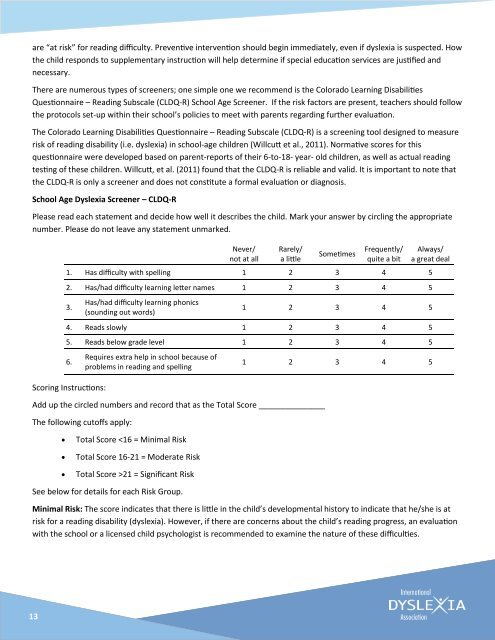Overcoming Dyslexia
Overcoming Dyslexia
Overcoming Dyslexia
Create successful ePaper yourself
Turn your PDF publications into a flip-book with our unique Google optimized e-Paper software.
are “at risk” for reading difficulty. Preventive intervention should begin immediately, even if dyslexia is suspected. How<br />
the child responds to supplementary instruction will help determine if special education services are justified and<br />
necessary.<br />
There are numerous types of screeners; one simple one we recommend is the Colorado Learning Disabilities<br />
Questionnaire – Reading Subscale (CLDQ-R) School Age Screener. If the risk factors are present, teachers should follow<br />
the protocols set-up within their school’s policies to meet with parents regarding further evaluation.<br />
The Colorado Learning Disabilities Questionnaire – Reading Subscale (CLDQ-R) is a screening tool designed to measure<br />
risk of reading disability (i.e. dyslexia) in school-age children (Willcutt et al., 2011). Normative scores for this<br />
questionnaire were developed based on parent-reports of their 6-to-18- year- old children, as well as actual reading<br />
testing of these children. Willcutt, et al. (2011) found that the CLDQ-R is reliable and valid. It is important to note that<br />
the CLDQ-R is only a screener and does not constitute a formal evaluation or diagnosis.<br />
School Age <strong>Dyslexia</strong> Screener – CLDQ-R<br />
Please read each statement and decide how well it describes the child. Mark your answer by circling the appropriate<br />
number. Please do not leave any statement unmarked.<br />
Scoring Instructions:<br />
Add up the circled numbers and record that as the Total Score _______________<br />
The following cutoffs apply:<br />
Never/<br />
not at all<br />
Rarely/<br />
a little<br />
Sometimes<br />
Frequently/<br />
quite a bit<br />
Always/<br />
a great deal<br />
1. Has difficulty with spelling 1 2 3 4 5<br />
2. Has/had difficulty learning letter names 1 2 3 4 5<br />
3.<br />
Has/had difficulty learning phonics<br />
(sounding out words)<br />
1 2 3 4 5<br />
4. Reads slowly 1 2 3 4 5<br />
5. Reads below grade level 1 2 3 4 5<br />
6.<br />
Requires extra help in school because of<br />
problems in reading and spelling<br />
1 2 3 4 5<br />
<br />
<br />
<br />
Total Score 21 = Significant Risk<br />
See below for details for each Risk Group.<br />
Minimal Risk: The score indicates that there is little in the child’s developmental history to indicate that he/she is at<br />
risk for a reading disability (dyslexia). However, if there are concerns about the child’s reading progress, an evaluation<br />
with the school or a licensed child psychologist is recommended to examine the nature of these difficulties.<br />
13

















